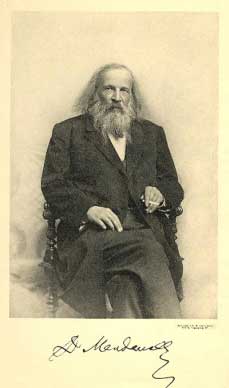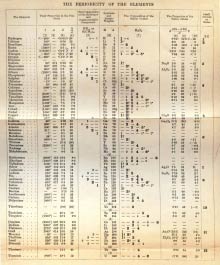
October 31, 2008
I’ve been thinking a lot about the periodic table of elements lately. (Fancier interactive version here.) It came to mind by way of the eclipse story—because the first person to view an eclipse from the air, in a hot-air balloon, was the fascinating Russian chemist Dmitri Mendeleev, whose great achievement it was. I remember being introduced to the periodic table in high school, feeling the pupils of my eyes go wide as I understood its revelation of a rational, almost musical structure in nature. We understand it better now—Mendeleev organized the elements by their atomic weight, while the Rutherford-Bohr model of the atom revealed that it is atomic number, or charge, and specifically the configuration of electrons, that determines an element’s chemistry—but the basic order of the table has held firm through all subsequent refinements.
Mendeleev was said to have solved the problem of the table’s structure in a dream, but that is now regarded as a myth—one that he himself may have concocted or exaggerated. Mendeleev was an early prototype of the self-mythologizing celebrity; his biographer, Michael D. Gordin of Princeton, says in a (subscription-only) article that “his greatest invention [was] himself.” (He was also the James Randi of his time, a scientific skeptic who made an avocation of debunking spiritualist séances. This had a surprising connection to his work as a pioneering meteorologist [PDF], in futile pursuit of the “universal ether”—a discredited concept which may now be making something of a comeback as an alternative to dark energy.) There’s something so lugubriously Russian about this site, which candidly calls Mendeleev’s dream a “legend” but then shows endless haunting pictures of the now abandoned, ruined mansion in which he is supposed to have dreamed it. The site also says that Russians of his time believed Mendeleev invented vodka.
Now his periodic table has been brought to life in a delightful new way: the Periodic Table of Videos. Chemists at the University of Nottingham, England, have made a short video for each element, packed with scientific information but also with the hands-on, sensory appeal of a kid’s chemistry set. You click on any square of the periodic table to view the video about that element. The scientists who demonstrate, creating little explosions, fires, and colorful reactions, are wonderfully geeky and dotty, and the videos have a homemade look. Here’s the one about helium, in which you just know that sooner or later the guys are going to sip from a balloon and talk like a duck, and you’re not disappointed:
In a burst of readerly overambition, I decided to get Gordin’s 2004 biography of Mendeleev, A Well-Ordered Thing (much of which can be browsed on Google Books, with the occasional annoying embargoed page), and read it in tandem with Primo Levi’s The Periodic Table, the Italian chemist and Holocaust survivor’s memoir in anecdotes, each associated with a different element. It was originally titled Il sistema periodico—which was what Mendeleev called his baby: The Periodic System. Amazon reader-reviewers capture the perennial enchantment Mendeleev’s system holds for the human imagination:
In a story named “Gold,” Italian writer Primo Levi tells us that he had always wanted to write about the saga of an atom of carbon to make people understand the solemn poetry, known only to chemists. And he did write this story—and it is the last one in his book called "The Periodic Table". It is curious to notice that both stories "Carbon" and "Gold" are the most important ones in this book.

* * *

Levi paints an intriguing portrait of a chemist, a detective unraveling the secrets of matter, a philosopher searching for meaning. We learn much about the kinds of problems that excite a chemist and how a chemist goes about searching for answers. But we learn more about Levi himself, about life in a Fascist state, and about human relationships in difficult situations.

Primo Levi titled each chapter with the name of an element that either plays a role in that particular chapter or exhibits characteristics that are metaphorically descriptive of human relationships portrayed in that chapter.

Most chapters revolve about an important biographical event. However, the first chapter, Argon, tells a rather quiet (inert) story of the unexciting Levi family history . . . Hydrogen, the second chapter, is more exciting, almost explosive. Zinc, Iron, Potassium, Nickel, and others follow.

Three chapters—Lead, Mercury, and Carbon—are fictional. I was absolutely fascinated by all three. . . . Lead should be read by students of history and Mercury likewise. Carbon should be mandatory reading for all students of chemistry and biology, probably for all humanities majors too.



(Annie Gottlieb) |
Comments (add yours!)

Return to September-October home
|






